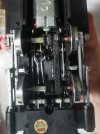Hello Richard,
The LGB Feldbahn loco's are quite 'delicate' compared to other LGB offerings, and it is easy to strain the mechanism..
It would need a higher setting, compared to analogue loco's, due to needing 5-6V to 'wake up' the electronics. - Analogue loco's tend to move at 2-3V.
I would guess that the drive-belt has stretched (possibly the gear on the driven axle is worn?) and there is just enough slop in the drive for the mechanism to lock-up in one direction.
You can (sometimes) get replacement axles from Marklin, but there is another way, though not for the faint-hearted!
Both axles have the worm-gear fitted on all the models I have worked on.
It is possible to swap the good gear to the driven axle. - You can't just swap the axles front to back, as the mountings for the rods are different.
This means you have to take the motor-block apart. - WARNING! there are tiny ball-bearings at the ends of the motor-shaft. Don't lose them.
You then have to remove one wheel and the good gear from the one axle. - Getting the wheel back on in exactly the right place.
Then remove a wheel and the worn gear from the other axle. Fit the new gear, then get that wheel back on in the right place.
Not easy, and you may well need to replace the drive-belt anyway (good practice).
Sometimes you may need to remove a wheel, and put it back on in a slightly different place, but usually moving the driven axle one-tooth one way or the other, will make the loco run more smoothly if it is a little jerky.
PhilP


